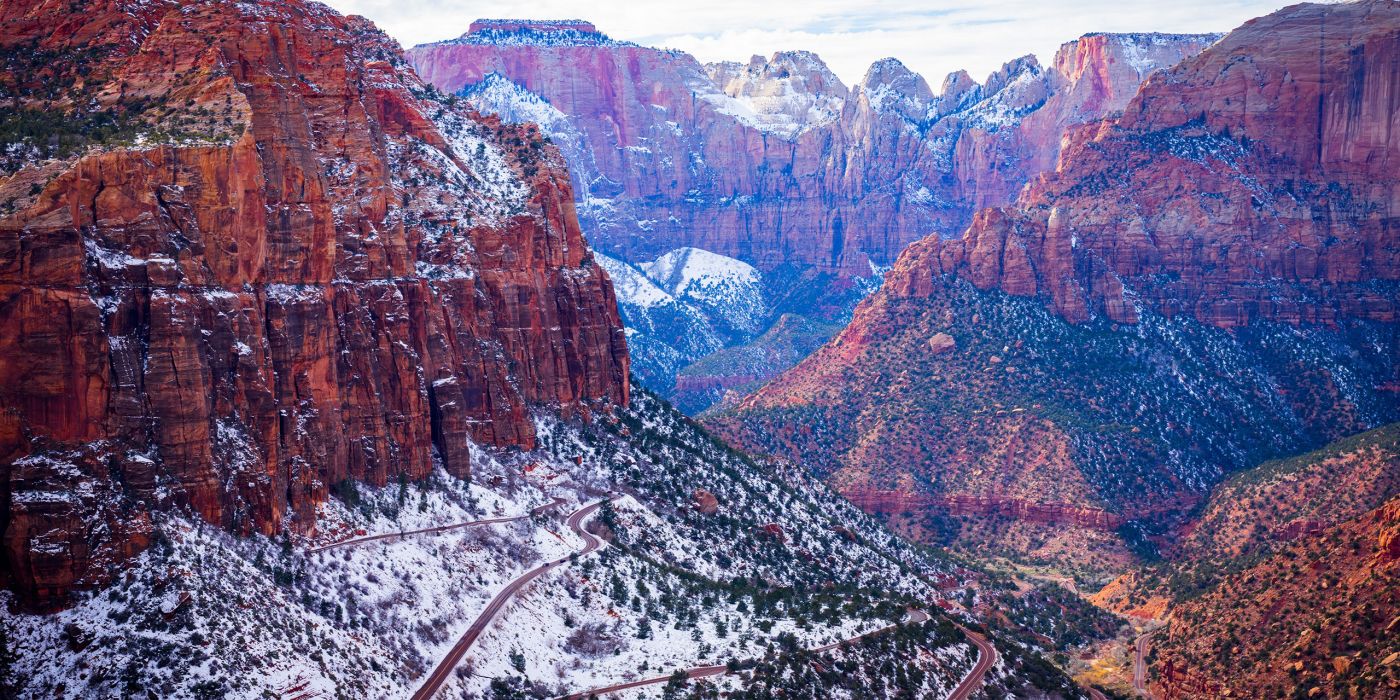
Zion National Park is a world-renowned destination for outdoor enthusiasts and nature lovers. While it’s often associated with the warm months of spring and summer, visiting Zion in the winter is a well-kept secret that offers a unique and appealing experience. We will explore the hidden charms of Zion National Park during the winter season, highlighting the winter-time fun, as well as the pros and cons of traveling here in the colder months.
Winter-Time Fun
One of the most striking aspects of visiting Zion National Park in the winter is the serene beauty that blankets the landscape. Snow-capped red rock formations, frosty waterfalls, and quiet trails create a peaceful atmosphere that allows you to connect with nature in a way that is rarely experienced during the busier summer months.
While some trails may be closed or challenging to access due to snow and ice, others remain open and offer a thrilling hiking experience. Popular winter hikes include the Riverside Walk, Lower Emerald Pools, and the Watchman Trail. It’s essential to check trail conditions and be prepared with appropriate gear like crampons or microspikes.
The winter season provides excellent opportunities for wildlife sightings, as animals become more active in search of food. Keep an eye out for deer, bighorn sheep, and the park’s resident foxes, who may be easier to spot against the snowy backdrop.
The clear, crisp winter nights in Zion are perfect for stargazing. The absence of light pollution and the cold, dry air make it an ideal setting to observe the cosmos. The park occasionally hosts stargazing events and ranger-led astronomy programs, providing insights into the celestial wonders above.
Choosing Zion’s Oasis: Amangiri and Zion Lodge Retreats
Selecting accommodation in Zion National Park means delving into the heart of Utah’s red-rock wonders, and two exceptional options stand out: Amangiri and Zion Lodge. Amangiri, a luxury resort tucked into the desert landscape, offers a seamless blend of modern architecture and natural beauty. With breathtaking views, private suites, and a spa that echoes the tranquility of the surroundings, Amangiri provides an unparalleled retreat. On the other hand, Zion Lodge, located within the park, offers a more immersive experience in nature. Its rustic charm, nestled against towering sandstone cliffs, places guests in the midst of Zion’s iconic scenery. With comfortable rooms and proximity to popular trails, Zion Lodge caters to those seeking a more traditional and convenient national park lodging experience. Whether it’s the desert luxury of Amangiri or the close-to-nature ambiance of Zion Lodge, both options promise an unforgettable stay in the heart of Zion National Park.
Pros of Visiting Zion National Park in Winter
- Reduced Crowds: Zion is a popular destination, and during the summer, it can get quite crowded. In the winter, however, you’ll find fewer visitors, allowing for a more intimate and peaceful experience.
- Mild Temperatures: While winters in Zion are cold, they are generally milder compared to many other national parks in the region. You can escape the extreme heat of summer and enjoy hiking in cooler, more comfortable conditions.
- Lower Accommodation Costs: With the decrease in visitors, you’ll likely find better availability and more affordable lodging options in the nearby towns of Springdale and St. George.
- Unique Photography Opportunities: The winter landscape transforms Zion into a stunning photographic wonderland, with contrasting colors, icy textures, and dramatic lighting. It’s a photographer’s dream come true.
Cons of Visiting Zion National Park in Winter
- Weather Uncertainties: Winter weather in Zion can be unpredictable, with occasional snowstorms and icy conditions. It’s crucial to be prepared for changing conditions and have the appropriate gear and clothing.
- Limited Accessibility: Some park roads and trails may be closed due to snow or icy conditions, restricting access to certain areas. It’s essential to check for trail updates and closures before planning your trip.
- Shorter Days: Winter days are shorter, providing less daylight for outdoor activities. Plan your hikes accordingly and consider that some trails may be best explored in the morning.
- Colder Temperatures: While milder than other parks in the region, Zion’s winter temperatures can still be quite chilly. Dress in layers, bring warm clothing and be prepared for colder nights.
Visiting Zion National Park in the winter offers a unique and enchanting experience, providing an opportunity to explore the park’s wonders with fewer crowds, serene landscapes, and a range of winter activities. While there are some cons, such as the unpredictable weather and limited trail accessibility, the pros, including reduced crowds, milder temperatures, and stunning photography opportunities, make it a rewarding choice for those seeking a quieter and more intimate adventure. So, pack your winter gear and prepare for an unforgettable winter wonderland in Zion National Park.
If you’re seeking stunning autumn landscapes, don’t miss our guide on “Autumn in Utah: A Journey Through Vibrant Fall Foliage Destinations.” Discover breathtaking spots to experience the rich colors of fall across Utah’s scenic parks and trails. For more travel inspiration and tips on enjoying Utah in autumn, be sure to follow us on Instagram. Let us help you plan the ultimate fall foliage adventure in Utah!
Get Inspired

Discover Tucson’s Most Charming Neighborhoods

Savor the Flavors of Tucson: Top-Rated Restaurants You’ll Love


